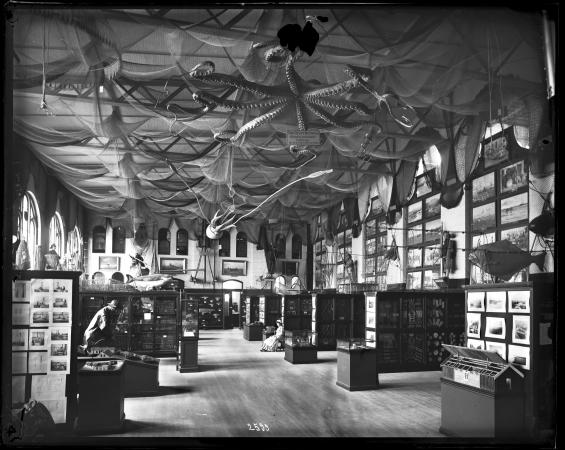Collecting isn’t easy, especially when the desired specimens are slippery, scaly, and wriggling fish. Turn back the clock 150 years and the task becomes even more difficult as less and less is known about some of the most common and studied species today. Such was the challenge that faced early directors of the U.S. National Museum (USNM). Spencer F. Baird and his successor, George Brown Goode, solicited donations, visited fish markets, and even caught a few specimens to fill cabinets in the Arts and Industries Building.

Baird and Goode also relied on an extensive network of contacts to acquire fish for study and display. They met hundreds of academics, fishermen, passionate amateurs, and salesmen through their participation in the U.S. Fish Commission. In addition to serving as the USNM’s first director—and soon after, second Secretary of the Smithsonian—Baird acted as the first Commissioner of the United States Commission of Fish and Fisheries. The Commission’s goals, which were largely economic, dovetailed with the Smithsonian’s academic mission to increase and diffuse knowledge. By investigating “whether any and what diminution in the number of the food-fishes of the coast and the lakes of the United States has taken place,” Baird researched the diverse ecosystems of North American fish and shared his findings in Smithsonian publications and exhibits. When he chose Goode as his assistant in 1872, the young ichthyologist entered, and expanded, his mentor’s network while also contributing new scholarship and fishes to the Smithsonian’s collections.

A brief examination of some letters between Baird, Goode, and their contacts illustrates the often informal—and sometimes precarious—nature of collecting fish for research and exhibit. In July 1880, a W. N. Lockington from San Francisco promised to “procure any rare fish I may find in the [local] markets.” He asked Baird and Goode to forward him “rather a big” list of Smithsonian publications in return for his services. The Smithsonian sent free copies of its publications to anyone who solicited them, but Baird and Goode readily offered the documents to individuals who helped gather information or specimens for the Commission and USNM.

Not all requests were honored, however. Throughout the 1870s and 80s, Goode remained in regular contact with Fred Mather, a naturalist-turned-profiteer who owned and operated a fishpond in Buffalo, New York. Periodically he mailed fish to the Smithsonian, often “alive in a small box of wet moss by Express.” He enjoyed supporting the scholarship conducted by the Smithsonian, but, as he explained to Goode in 1874, “most of my time has to be devoted to procuring the requisite amount of ‘hash’ to sustain nature.” The hash in question was money, and Mather made his by selling fish raised in his ponds and tickets to self-curated exhibits at shows and fairs. Once, he asked Goode for a skate fish to pass off as “a mermaid…at the Poultry Show at Buffalo.” He implored Goode that he “need[ed] a ‘mermaid’ to astonish the natives” and increase admissions; the spiny skate fish was strange enough to wow onlookers. Mather planned to plead ignorance of the creature’s origins, and “call it Japanese or something else” to exoticize (and sell) the display. While there is no evidence to the contrary, it is doubtful that Goode sent Mather the ‘mermaid’ he desired. Afterall, the second director of the USNM sought to foster the Smithsonian’s reputation as a public repository for accurate and trusted information. Nonetheless, doing business with hucksters was not beneath Goode or Baird (within limits), especially if the specimens they procured could assist in the increase and diffusion of knowledge.
Related Collections
- Spencer F. Baird, Report on the Condition of the Sea Fisheries of the South Coast of New England in 1871 and 1872, Part 1 (Washington: Government Printing Office, 1873). Available via the Biodiversity Heritage Library:
- George Brown Goode Papers, Record Unit 7050, Smithsonian Institution Archives
- Spencer F. Baird Papers, Record Unit 7002, Smithsonian Institution Archives
Produced by the Smithsonian Institution Archives. For copyright questions, please see the Terms of Use.

Leave a Comment